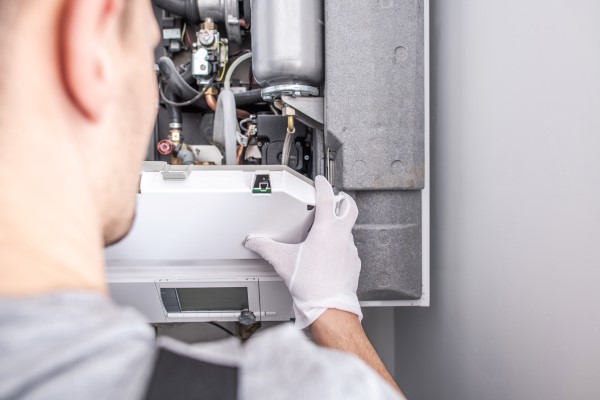How Weatherproofing Your Home Can Reduce Furnace Repair Needs
Call Us Anytime!
Keep Your Furnace Efficient
As the temperature drops and winter approaches, homeowners rely heavily on their furnaces to keep their homes warm and comfortable. However, many don’t realize that their home’s efficiency can directly impact the workload on their heating system.
Weatherproofing your home is one of the simplest and most effective ways to reduce the strain on your furnace, lower energy costs, and even minimize the likelihood of costly furnace repairs.
This comprehensive guide explores how weatherproofing protects your furnace, improves energy efficiency, and extends the lifespan of your heating system. We’ll also provide actionable tips to help you weatherproof your home for maximum impact.




The Connection Between Weatherproofing and Furnace Performance
Your furnace is designed to maintain a consistent temperature by heating the air inside your home. However, if your house isn’t properly sealed or insulated, warm air escapes while cold air seeps in, forcing your furnace to work overtime. This constant strain can lead to several issues:
- Increased Wear and Tear: A furnace that runs constantly is more likely to experience component failures, such as a worn-out blower motor or heat exchanger cracks.
- Shortened Lifespan: Overworking your furnace reduces its efficiency over time and shortens its overall lifespan, leading to premature replacement.
- Higher Energy Bills: When your furnace struggles to compensate for heat loss, it consumes more energy, significantly increasing your heating costs.
- Frequent Repairs: Excessive use can lead to more frequent breakdowns, resulting in higher repair bills.
Weatherproofing your home reduces the burden on your furnace by keeping warm air inside and cold air out, helping it operate efficiently and with less stress.
Benefits of Weatherproofing Your Home
Weatherproofing offers numerous benefits for homeowners, including:
- Lower Heating Costs: By preventing heat loss, your furnace runs fewer cycles, reducing energy consumption and lowering utility bills.
- Increased Comfort: A weatherproofed home maintains a consistent temperature, eliminating cold drafts and uneven heating.
- Fewer Repairs: Reducing strain on your furnace decreases the likelihood of breakdowns and costly furnace repairs.
- Environmental Impact: Improved energy efficiency lowers your home’s carbon footprint by reducing the amount of energy needed to maintain a comfortable temperature.
- Longer Furnace Lifespan: Less wear and tear on your furnace can extend its useful life, delaying the need for expensive replacements.
Key Weatherproofing Strategies to Reduce Furnace Strain
To get the most out of your weatherproofing efforts, focus on areas where heat loss is most likely to occur. Here are some practical steps to ensure your home is sealed and insulated effectively:
Seal Gaps and Cracks Around Windows and Doors
Windows and doors are some of the most common areas for heat to escape. Even small gaps can have a significant impact on your home’s overall energy efficiency.
- Weatherstripping: Install weatherstripping around doors and windows to create a tight seal. This inexpensive material is easy to apply and effectively blocks drafts.
- Caulking: Use caulk to seal cracks and gaps around window frames, door frames, and other openings. Ensure you use exterior-grade caulk for areas exposed to the elements.
- Door Sweeps: Attach a door sweep to the bottom of exterior doors to prevent cold air from entering your home.
Insulate Your Home Properly
Proper insulation is crucial for keeping warm air inside and reducing the workload on your furnace. Focus on areas where heat loss is most likely:
- Attic Insulation: Heat rises, so the attic is one of the most important areas to insulate. Use high-quality insulation, such as fiberglass or spray foam, to create a thermal barrier that prevents heat from escaping through the roof.
- Wall Insulation: Older homes often lack sufficient insulation in the walls. If this is the case, consider adding blown-in insulation or upgrading existing materials to improve efficiency.
- Basement and Crawl Spaces: Insulate your basement walls and crawl space floors to reduce heat loss from below your home.
Install Energy-Efficient Windows
If your windows are old or single-pane, they may be a significant source of heat loss. Upgrading to energy-efficient windows can dramatically improve your home’s insulation and reduce strain on your furnace repair.
- Double or Triple-Pane Windows: These windows have multiple layers of glass with insulating gas in between, providing superior thermal performance.
- Low-E Coatings: Windows with Low-E (low emissivity) coatings reflect heat back into your home, reducing energy loss.
- Storm Windows: If replacing windows isn’t an option, installing storm windows can add an extra layer of insulation.
Use Window Treatments to Conserve Heat
Window treatments can provide an additional layer of insulation and prevent heat from escaping through glass panes.
- Thermal Curtains: These curtains are lined with insulating material to keep warm air inside and block drafts.
- Cellular Shades: Also known as honeycomb shades, these window coverings trap air in their pockets, creating a thermal barrier.
- Reflective Films: Apply reflective window films to reduce heat loss while still allowing natural light into your home.
Prevent Drafts in Unused Areas
Drafts can occur in areas that aren’t frequently used, such as chimneys, attics, and unused rooms. Addressing these drafts can make a big difference:
- Chimney Draft Stoppers: Use a chimney balloon or damper to block drafts when the fireplace isn’t in use.
- Close Off Unused Rooms: Seal off unused rooms by closing doors and vents to prevent heat from escaping into areas you don’t occupy.
- Insulated Covers for Attic Hatches: Install an insulated cover over your attic access point to prevent warm air from escaping.
Check and Seal Ductwork
Leaky ductwork can result in significant heat loss, reducing the efficiency of your furnace. Inspect your ducts for gaps, holes, or disconnected sections, and seal them with duct tape or mastic sealant. Insulating ducts in unconditioned spaces, such as basements or attics, can further improve efficiency.
Upgrade Your Thermostat
A programmable or smart thermostat can help optimize your furnace’s performance and reduce energy consumption.
- Programmable Thermostats: Schedule heating cycles to match your daily routine, lowering the temperature when you’re away or asleep.
- Smart Thermostats: These devices learn your preferences and automatically adjust settings for maximum efficiency.
Using a thermostat effectively prevents your furnace from overworking and helps maintain a consistent temperature in your home.
Additional Tips for Reducing Furnace Strain
In addition to weatherproofing, adopting good maintenance habits can further prevent furnace repairs and ensure it runs efficiently:
- Replace Furnace Filters Regularly: Clogged filters restrict airflow, forcing your furnace to work harder. Replace or clean filters every 1–3 months during the heating season.
- Schedule Annual Maintenance: A professional HVAC inspection and tune-up can identify potential issues and keep your furnace running at peak efficiency.
- Keep Vents and Registers Clear: Blocked vents reduce airflow and make your furnace work harder. Ensure that furniture, rugs, or curtains aren’t obstructing heat distribution.
- Add a Humidifier: Dry air feels colder, prompting you to turn up the heat. Using a humidifier can improve comfort and reduce the workload on your furnace.
The Long-Term Benefits of Weatherproofing
Weatherproofing your home provides a wide range of long-term benefits that go beyond just reducing heating costs during the winter months. By enhancing your home’s energy efficiency and reducing strain on your furnace, you can enjoy several lasting advantages that impact your comfort, your finances, and even the environment. Let’s dive deeper into the extended benefits of weatherproofing:
Significant Savings on Energy Bills
Weatherproofing your home reduces heat loss, which means your furnace doesn’t need to work as hard or run as often to maintain a comfortable temperature. Over time, this translates to substantial savings on your energy bills. For example:
- Reduced Heating Costs: With proper sealing, insulation, and energy-efficient upgrades, homeowners can save up to 20–30% on their heating expenses annually. Over the lifetime of your home, these savings add up to thousands of dollars.
- Lower Cooling Costs: Weatherproofing doesn’t just help in winter—it also keeps your home cooler in the summer by preventing heat from entering, reducing the strain on your air conditioning system.
By investing in weatherproofing, you create a more energy-efficient home that saves you money year after year.
Extended Furnace Lifespan
A furnace that isn’t overworked is less likely to experience frequent breakdowns or premature failure. When your home is well-sealed and insulated, your furnace operates at its intended capacity, rather than being pushed to its limits. This has several long-term benefits:
- Fewer Repairs: Weatherproofing minimizes the wear and tear on your furnace, reducing the likelihood of costly furnace repairs. For example, components like the blower motor or heat exchanger last longer when the system isn’t constantly cycling.
- Delayed Replacement: The average furnace lifespan is 15–20 years, but overworking it can significantly shorten this timeframe. Weatherproofing helps your furnace last its full lifespan, delaying the need for an expensive replacement.
Protecting your furnace through weatherproofing ensures that you get the most value out of your heating system investment and avoid more furnace repairs than needed.
Increased Comfort Year-Round
A weatherproofed home maintains a consistent indoor temperature, eliminating common issues like drafts, cold spots, or uneven heating. The result is a more comfortable living environment for you and your family, no matter the season. Key benefits include:
- Even Heating: Properly sealed and insulated homes distribute heat more evenly, ensuring every room stays warm and cozy.
- Eliminated Drafts: Weatherproofing stops cold air from sneaking in through gaps or poorly sealed areas, improving the overall comfort of your home.
By addressing areas of heat loss, you create a home environment that’s consistently warm in winter and pleasantly cool in summer.
Improved Indoor Air Quality
Weatherproofing doesn’t just keep out the cold—it also prevents outdoor pollutants, allergens, and moisture from entering your home. This can significantly improve your indoor air quality, especially when combined with regular furnace maintenance. Benefits include:
- Reduced Allergens: Sealing gaps and insulating properly prevents dust, pollen, and other allergens from infiltrating your home.
- Less Mold and Mildew: By controlling moisture levels with proper weatherproofing, you reduce the risk of mold growth, which can harm your family’s health.
- Enhanced HVAC Performance: Cleaner air filters and ducts mean your furnace circulates healthier, fresher air throughout your home.
Better air quality contributes to a healthier and more comfortable living space for everyone in your household.
Increased Home Value
Investing in weatherproofing not only benefits you while you live in your home but can also make your property more appealing to potential buyers if you decide to sell. Energy-efficient homes are highly desirable in today’s market, and buyers are often willing to pay a premium for properties that are weatherproofed and well-insulated. Key selling points include:
- Energy Efficiency Ratings: Many homebuyers look for energy-efficient features that promise lower utility bills and reduced environmental impact.
- Upgraded Windows and Insulation: Features like double-pane windows and attic insulation make your home stand out in a competitive market.
- Documented Savings: Showing proof of reduced heating and cooling costs over time can be a persuasive selling tool.
Weatherproofing increases your home’s value and offers a solid return on investment when it’s time to sell.
Environmental Impact
A weatherproofed home isn’t just good for your wallet—it’s also better for the planet. By reducing your home’s energy consumption, you’re helping to lower greenhouse gas emissions and combat climate change. Here’s how:
- Lower Carbon Footprint: With less energy needed to heat and cool your home, you’re reducing the demand on fossil fuel-based energy sources.
- Sustainable Living: Weatherproofing aligns with sustainable living practices by conserving resources and minimizing waste.
Choosing eco-friendly materials and practices during the weatherproofing process further enhances your home’s environmental benefits.
Protection Against Extreme Weather
As climate patterns shift and extreme weather events become more common, a weatherproofed home offers added protection against the elements. Whether it’s a polar vortex in the winter or a heatwave in the summer, a well-insulated and sealed home can help you weather the storm. Benefits include:
- Resilience Against Cold Snaps: Proper insulation and sealing ensure your home retains heat even during extended periods of extreme cold, reducing the risk of frozen pipes or overworked heating systems.
- Reduced Impact of Power Outages: A well-insulated home retains heat longer, keeping your family safe and comfortable during power outages caused by storms.
Weatherproofing your home today can safeguard it against the challenges of tomorrow.
Avoid Furnace Repairs with Effective Weatherproofing
Your furnace is one of the hardest-working systems in your home during the winter months, but it doesn’t have to carry the burden alone. Weatherproofing your home is a simple yet effective way to reduce strain on your furnace, lower energy bills, and minimize the need for furnace repairs. By sealing gaps, adding insulation, upgrading windows, and adopting energy-saving practices, you can ensure your furnace operates efficiently all season long.
Start weatherproofing your home this fall to reap the benefits of a warm, comfortable, and cost-efficient winter. With a little effort, you’ll protect your furnace and your wallet for years to come.

